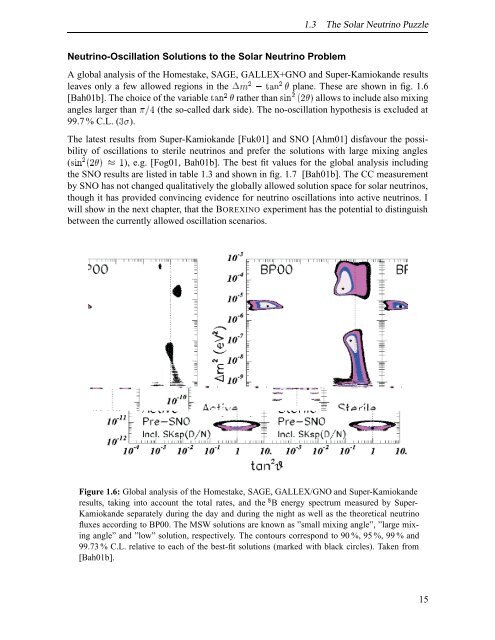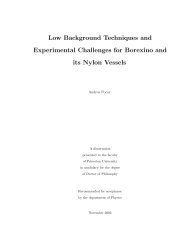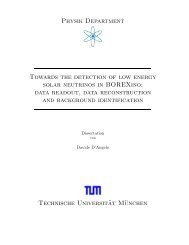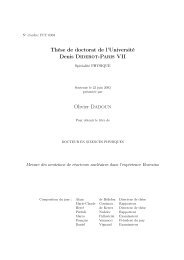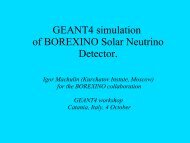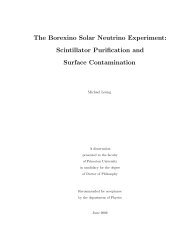Development of a Liquid Scintillator and of Data ... - Borexino - Infn
Development of a Liquid Scintillator and of Data ... - Borexino - Infn
Development of a Liquid Scintillator and of Data ... - Borexino - Infn
You also want an ePaper? Increase the reach of your titles
YUMPU automatically turns print PDFs into web optimized ePapers that Google loves.
Neutrino-Oscillation Solutions to the Solar Neutrino Problem<br />
1.3 The Solar Neutrino Puzzle<br />
A global analysis <strong>of</strong> the Homestake, SAGE, GALLEX+GNO <strong>and</strong> Super-Kamiok<strong>and</strong>e results<br />
leaves only a few allowed regions in the ¡Ñ ØÒ plane. These are shown in fig. 1.6<br />
[Bah01b]. The choice <strong>of</strong> the variable ØÒ rather than ×Ò allows to include also mixing<br />
angles larger than (the so-called dark side). The no-oscillation hypothesis is excluded at<br />
99.7 % C.L. ( ).<br />
The latest results from Super-Kamiok<strong>and</strong>e [Fuk01] <strong>and</strong> SNO [Ahm01] disfavour the possibility<br />
<strong>of</strong> oscillations to sterile neutrinos <strong>and</strong> prefer the solutions with large mixing angles<br />
(×Ò ), e.g. [Fog01, Bah01b]. The best fit values for the global analysis including<br />
the SNO results are listed in table 1.3 <strong>and</strong> shown in fig. 1.7 [Bah01b]. The CC measurement<br />
by SNO has not changed qualitatively the globally allowed solution space for solar neutrinos,<br />
though it has provided convincing evidence for neutrino oscillations into active neutrinos. I<br />
will show in the next chapter, that the BOREXINO experiment has the potential to distinguish<br />
between the currently allowed oscillation scenarios.<br />
Figure 1.6: Global analysis <strong>of</strong> the Homestake, SAGE, GALLEX/GNO <strong>and</strong> Super-Kamiok<strong>and</strong>e<br />
results, taking into account the total rates, <strong>and</strong> the B energy spectrum measured by Super-<br />
Kamiok<strong>and</strong>e separately during the day <strong>and</strong> during the night as well as the theoretical neutrino<br />
fluxes according to BP00. The MSW solutions are known as ”small mixing angle”, ”large mixing<br />
angle” <strong>and</strong> ”low” solution, respectively. The contours correspond to 90 %, 95 %, 99 % <strong>and</strong><br />
99.73 % C.L. relative to each <strong>of</strong> the best-fit solutions (marked with black circles). Taken from<br />
[Bah01b].<br />
15


